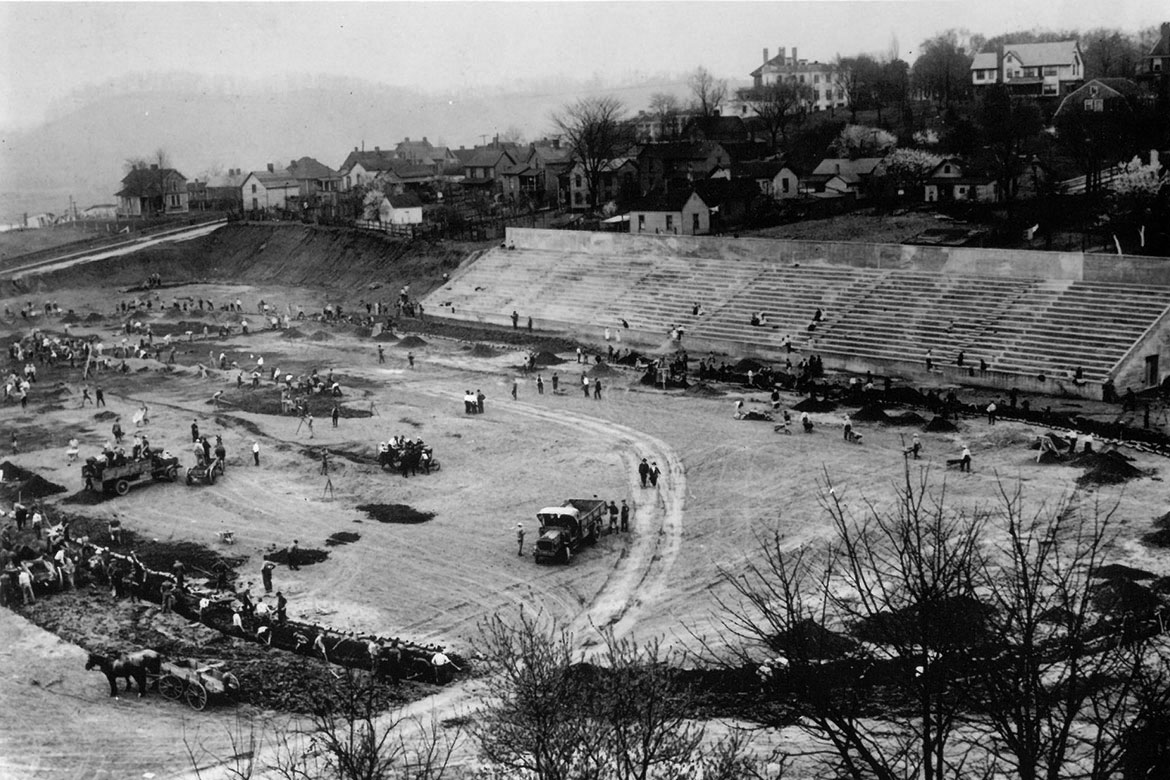Best I can tell, Tennessee has never lost an open date. That makes happy week an ideal time to review the first hundred years of exciting action on almost-sacred Shields-Watkins Field.
Because the university pretends the turf and surrounding concrete and steel are one and the same and I beg to differ, we’ll offer Neyland Stadium highlights tomorrow.
The playground was built from scratch in 1921. The first game was a 27-0 victory over Emory and Henry. It did not attract an overflow crowd. A year later, UT wore orange jerseys for the first time in a 50-0 win over the same dependable foe. See what a difference going orange made? See what a mistake alternate uniforms are?
The first game that really mattered was homecoming 1927, Nov. 12, announced attendance 14,000 plus a few who slipped in. The year before, young Bob Neyland had been elevated from assistant to head coach with the expressed challenge of lifting the Volunteers so they could go nose to nose with Vanderbilt, a national power. Tennessee had won two of the 22 previous meetings.
On this historic day, the teams tied, 7-7. So soon the pendulum was swinging.
After that came Hack, Mack and Dodd – Buddy Hackman, Gene McEver and Bobby Dodd – and the Flamin’ Sophomores of 1928. Things have never been the same.
In 1936, the Vols upset No. 2 Duke, Southern Conference champion. Red Harp’s 70-yard punt return decided the game.
The Vols enjoyed an undefeated 1938. The final five foes failed to score. Tennessee claimed the national championship. The Associated Press said it was second.
Johnny Butler’s famous run and defensive perfection were the highlights of 1939. The streak of shutouts reached 15. The victory margin was 381 to nothing. The big game was No. 5 Vols over No. 8 Crimson Tide, 21-0, noisy crowd of 31,000, national radio audience, four-page spread in Life magazine.
Legendary writer Grantland Rice described Butler as “a dancing, dodging, untacklable ghost.”
Sandra Clark and KnoxTNToday won’t let me write like that.
All Johnny Butler did was twice reverse his route and run from one side of the field to the other, which meant a lot of Alabama boys got blocked twice and were left wondering where the ghost might be going next. He covered half a mile to gain 56 yards. Touchdown Tennessee!
Two big ones on the grass in ’46 – Vols beat North Carolina and all-American Charlie (Choo-Choo) Justice and Alabama and Harry Gilmer, SEC player of the year.
Great teams and special backfield in 1950-1951 – Hank Lauricella, Andy Kozar, Bert Rechichar and Jimmy Hahn. Extra-large defender Doug Atkins wasn’t too bad. There was a meaningful 7-0 victory over Bear Bryant’s No. 3 Kentucky.
The first Smokey was elected mascot in 1953. Tom Mattingly’s intriguing Smokey book was published 59 years later.
Tennessee won an SEC championship in ’56. John Majors was runner-up for the Heisman Trophy.
In ’59, UT upset No. 1 LSU, defending national champion led by Heisman Trophy winner Billy Cannon. The unforgettable moment was “The Stop” of Cannon by Wayne Grubb, Charlie Severance and Bill Majors on a two-point conversion attempt.
Bob Johnson, Doug Dickey’s first recruit, got better and better, won the Jacobs Trophy ’67 and became a very special all-American. Can you imagine a center finishing sixth in Heisman voting?
The season opener in 1968 was interesting. Georgia and Tennessee were going to play for the first time in 31 years. Suddenly, they weren’t going to play. The Bulldogs, shocked to learn that the Vols had installed artificial turf, threatened to boycott, just not show up.
UT athletics director Bob Woodruff provided free turf shoes. Georgia relented, appeared as scheduled and thought it had won the game. Not so. On the final play, Bubba Wyche threw a touchdown pass to Gary Kreis. After that, Bubba completed a two-point conversion to Ken DeLong. Net result: 17-17, eight points after time expired. Vince Dooley said a bad word.
Interesting add-on: This was John Ward’s first game as voice of the Vols.
Best-ever trio of linebackers? Could be 1969, Steve Kiner, Jack Reynolds and Jackie Walker.
Doug Dickey had to come back to Shields-Watkins Field with the Florida Gators in 1970 and face the “music.” Some say he has repented for ever going away.
Good 1971-72 Penn State double memory. Bobby Majors celebrated “Majors Family Day” with 195 yards in punt and kickoff returns as the Vols ended the Nittany Lions’15-game winning streak.
Soon thereafter, coach Joe Paterno thought he saw an escape hatch from the next year’s come-again contract. He said the Lions would return to September heat only for a night game. Joe knew Tennessee had no lights.
He didn’t know how shrewd was Woodruff. Lights appeared in plenty of time. An enlightened Paterno became part of Tennessee’s first night game. Condredge Holloway led a Vol victory.
Herschel Walker and Bill Bates got personally acquainted during the season opener of 1980. Mike Terry intercepted a pass in the end zone to secure an upset victory over No. 2 Alabama in 1982. Two landmarks: Tennessee had lost 11 in a row to the Tide. This was Bear Bryant’s last visit. He died three months later.
On Sept. 28, 1985, Tony Robinson threw four touchdown passes and seized the spotlight from Auburn’s Bo Jackson. Defense helped. It knocked the S off Superman’s cape and caused him to seek the safety of the sideline.
There was something really special about Phillip Fulmer’s decade of dominance, especially the mid-1990s. Who or what was it? Oh, I remember now, it was Peyton Manning!
You may think 1998 was the best. That 20-17 thriller over Florida in overtime was a keeper. Al Wilson forced three fumbles. Jeff Hall kicked the go-ahead field goal. A Gator missed one to tie. John Ward said “no-sir-ree” several times. He also said “Pandemonium reigns.”
Fans tore down the goal posts and went marching along Cumberland Avenue. In this era, the university would be fined a few million for such unruly behavior. Back then, Gus Manning ordered new goal posts.
There was something truly unusual in that perfect season, the Clint Stoerner stumble and fumble. Billy Ratliff caused it and captured the ball. Travis Henry and the offensive line did the rest. Arkansas will never forget.
Alas and alas, nothing that good has happened since on historic Shields-Watkins Field. The Vols did win 10 or more four times. John Henderson earned the Outland Award. Eric Berry was outstanding. There was a James Wilhoit field goal of some significance, Casey Clausen threw some passes in six overtimes and Josh Dobbs made several remarkable plays.
Big Vols came and went – to the NFL.
If you want balanced reporting, there were a couple of unbelievable losses in years past. Chattanooga staged a stunning upset but Tennessee won the riot. North Texas State, heavy underdog, created shockwaves.
The steady decline during the Dooley-Jones-Pruitt era, recent results, disappointments and embarrassments have added value to the good, old days.
Best players of 100 years? Tough question, too tough. Twenty-one are in the College Football Hall of Fame.
Condredge is in mine. The Artful Dodger was a terrific subject for a storyteller. Richmond Flowers and Dewey Warren were almost as good.
Official honorees:
McEver, Dodd, Atkins, Lauricella, Manning, Kiner, Wilson, Beattie Feathers, Bob Suffridge, Herman Hickman, Nathan Dougherty.
George Cafego, Bowden Wyatt, John Majors, Bob Johnson, Ed Molinski, Steve DeLong, John Michels, Reggie White, Frank Emanuel, Chip Kell.
Marvin West welcomes reader comments or questions. His address is marvinwest75@gmail.com. Check back Friday for some Neyland Stadium stories.

